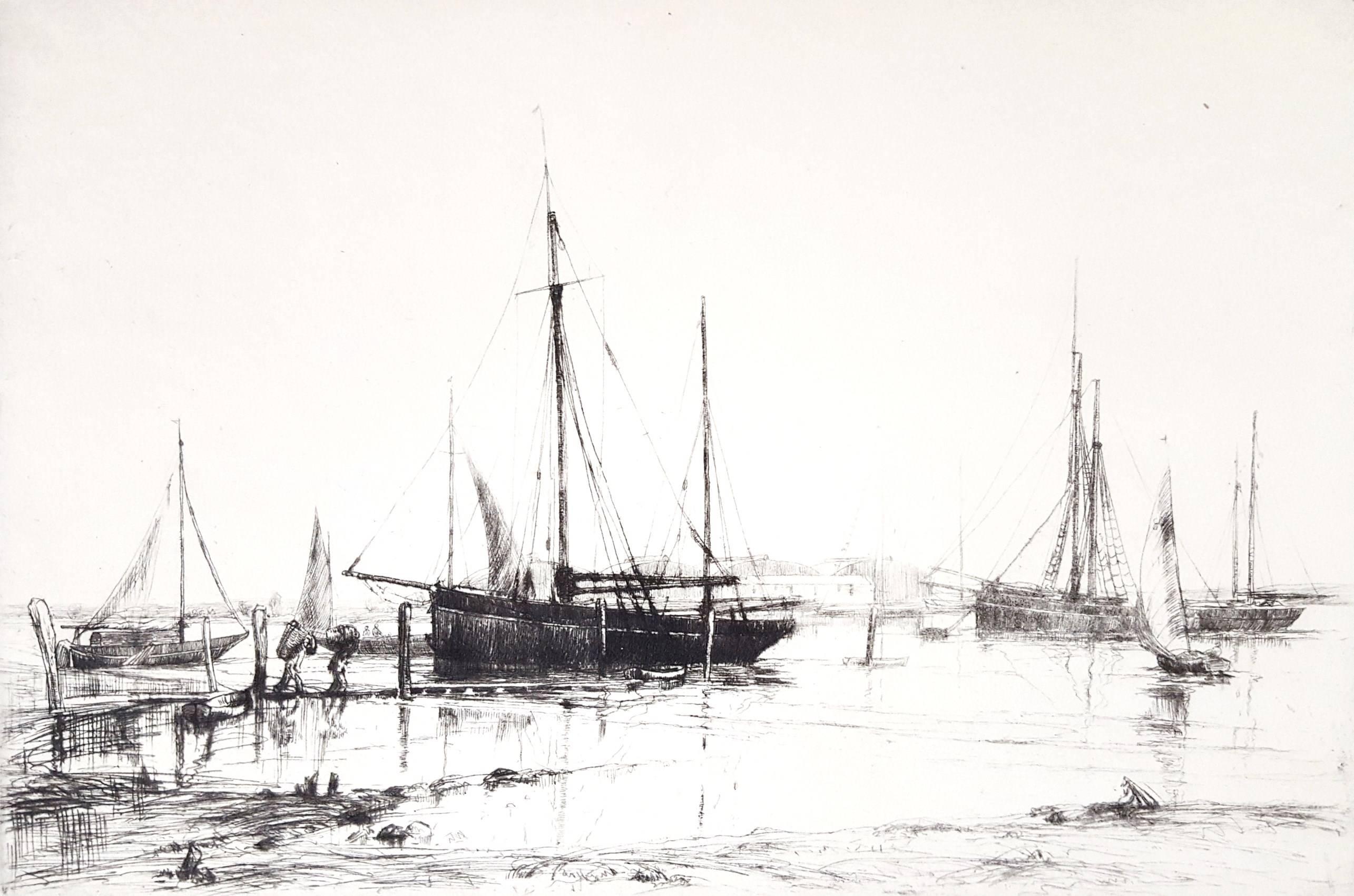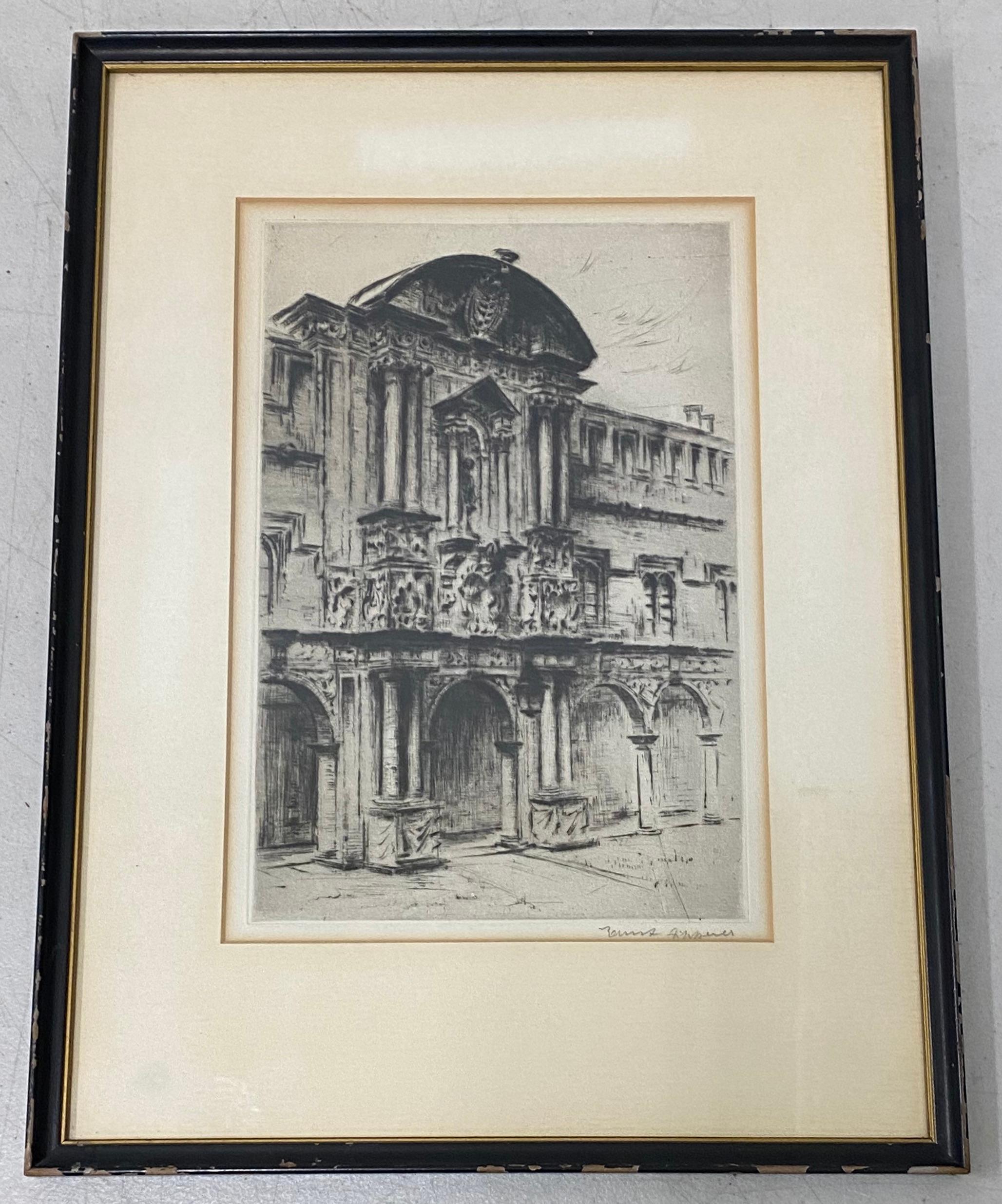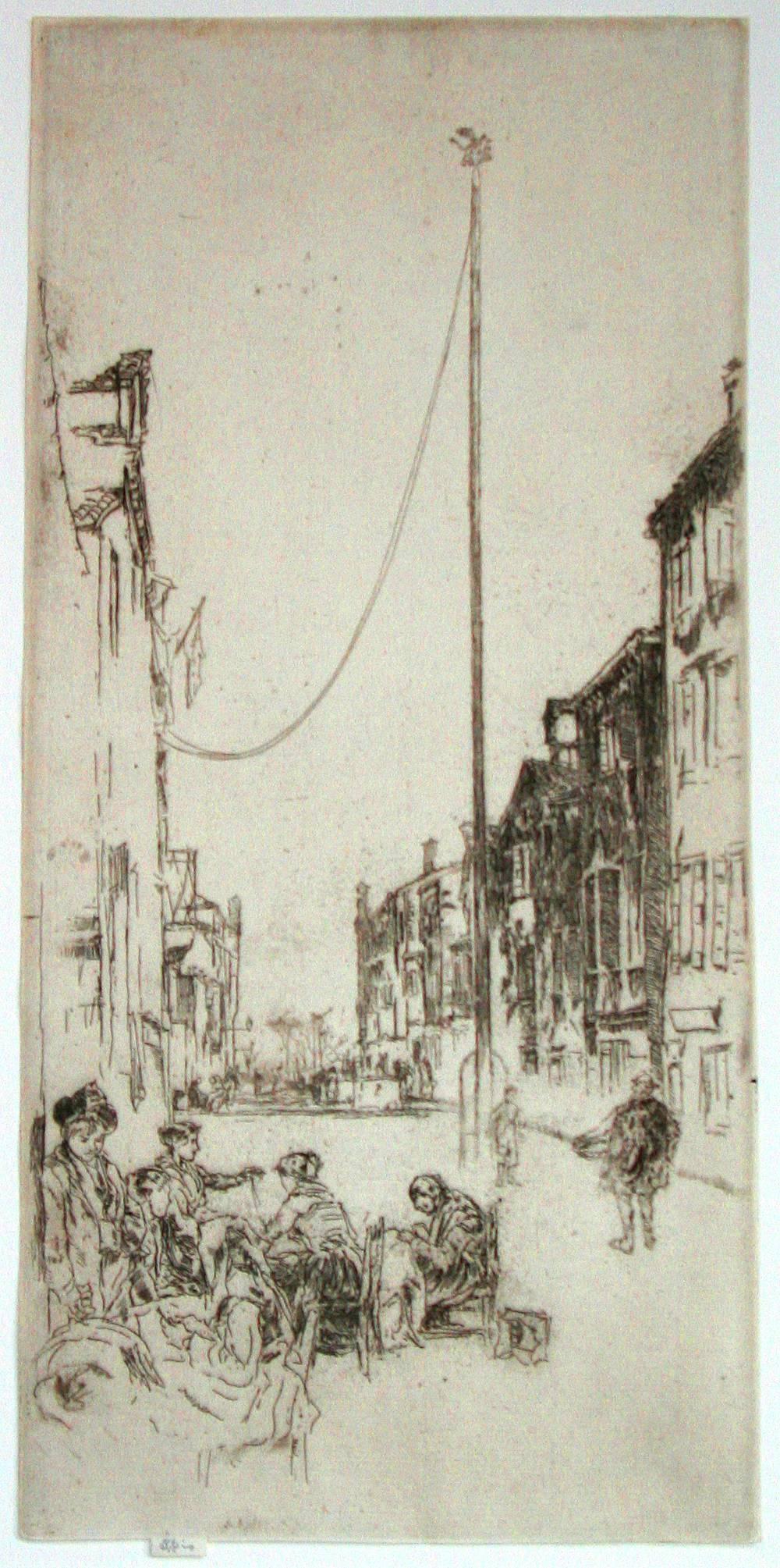Items Similar to Un Debarquement en Angleterre (A Disembarking in England)
Want more images or videos?
Request additional images or videos from the seller
1 of 6
Félix Hilaire BuhotUn Debarquement en Angleterre (A Disembarking in England)1879
1879
About the Item
Un Debarquement en Angleterre
(A Disembarking in England)
etching, drypoint, aquatint, roulette and spirit ground, 1879
Signed with the artist’s red owl stamp, Lugt 977 (see photo)
Very rich impression with burr and selective wiping of the plate to create atmospheric effect.
Printed on a cream fibrous “oatmeal” paper
Reference: Bourcard/Goodfriend 130 v/V
Provenance: Jeffrey M. Kap;an, Washington, D.C. (label)
Archival framing with OP3 Acrylic (see photo)
Condition: Printed on an antique tan paper for atmospheric effect. Stain in upper margin outside of plate mark and matting window
Very rich impression full of burr and selective inking to created an atmospheric effect.
Félix-Hilaire Buhot
French, 1847 - 1898
Among the most original prints made in France during the last quarter of the nineteenth century are those by Félix Buhot. Born in 1847 in the small Normandy town of Valognes, in northern France, Buhot moved to Paris in 1865, where a year later he enrolled in the École des Beaux-Arts, studying painting and drawing under various artists. Buhot first learned to etch in about 1873, producing his first etching later that year and quickly establishing himself as a successful printmaker. The young artist made his living by decorating fans and illustrating lithographic sheet music. Buhot lived and worked most of his life in Paris, with frequent visits back to northern France and extended trips to England where he met his wife, Henrietta Johnston, whom he married in 1881. By 1892 Buhot had ceased making prints, and in 1898, after suffering prolonged bouts of deep depression, he died at the age of fifty-one.
Along with Edgar Degas and Camille Pissarro, Félix Buhot numbers among the most experimental printmakers of his day. In exploring the unique aspects of etching, he developed an approach to printmaking that was very painterly; in fact he called his prints "paintings on copper." A true printmaker's printmaker, Buhot delighted in all the technical variables and regularly combined multiple processes to produce a single print: he achieved even greater tonal variation by employing the more traditional techniques of etching, drypoint, and aquatint along with several less familiar methods. Unlike many contemporary printmakers who disliked photography, Buhot heartily embraced the medium and used it as a creative aid. He also used different inks and papers for varied effects. His most original contribution to the history of printmaking is a device he termed marges symphoniques (symphonic margins): by amplifying the main subject, such illustrations became an integral part of the print.
In his many prints of city views and seascapes, Buhot was intent on creating a specific atmosphere, especially the effects of weather such as rain, snow, mist, and fog. He turned to his immediate neighborhood in and around the boulevard de Clichy in Montmartre, Paris, for inspiration for his prints of everyday city life. Buhot delighted in portraying the varied street life of the vibrant capital city not only in different seasons (Winter in Paris, 1879) but also in moments of public display, from a festive holiday celebration (National Holiday on the Boulevard de Clichy, 1878) to a somber death observance (Funeral Procession on the Boulevard de Clichy, 1887). His city views also include London scenes (Westminster Palace and Westminster Bridge, both of 1884). And Buhot's love for the sea is evidenced in the many prints exploring its ever-changing atmospheric conditions and moods. Buhot's boat trips to England inspired two of his most characteristic prints, A Pier in England and Landing in England, both from 1879.
With his experimental printmaking techniques, Buhot became one of the best-known, admired, and collected printmakers of his day. He achieved success for his prints at the annual Salons between 1875 and 1886, and a number of his works were published in leading periodicals and books. He also found critical acclaim and support for his prints in the United States, especially after his first one-man exhibition organized by the New York print dealer Frederick Keppel in 1888.
Courtesy: National Gallery of Art, Washington, D. C.
- Creator:Félix Hilaire Buhot (1847 - 1898, French)
- Creation Year:1879
- Dimensions:Height: 11.875 in (30.17 cm)Width: 7 in (17.78 cm)
- Medium:
- Movement & Style:
- Period:
- Condition:Cleaned by Alan Firkser Printed on an antique tan paper for atmospheric effect. Stain in upper margin outside of plate mark and matting window Archival framing with OP3 Acrylic and metal leaf frame.
- Gallery Location:Fairlawn, OH
- Reference Number:
About the Seller
5.0
Recognized Seller
These prestigious sellers are industry leaders and represent the highest echelon for item quality and design.
Platinum Seller
These expertly vetted sellers are 1stDibs' most experienced sellers and are rated highest by our customers.
Established in 1978
1stDibs seller since 2013
711 sales on 1stDibs
Typical response time: 1 hour
Associations
International Fine Print Dealers Association
- ShippingRetrieving quote...Ships From: Fairlawn, OH
- Return PolicyA return for this item may be initiated within 10 days of delivery.
More From This SellerView All
- Untitled (Venice canal, man departing the gondola)By Levon WestLocated in Fairlawn, OHUntitled (Venice canal, man departing the gondola) Drypoint, c. 1930-1931 Signed in pencil lower right (see photo) Annotated in the lower margin: "Just a souvenir made ___ Monclair Lecture" Levon West In a supplemental list prepared by Otto Torrington he lists seven views of Venice. No edition of these Vencie images was ever printed. Only rare proof exist. I cannot find another impression of this image on line or in reference books. Condition: Very good impression with selective inking to the plate. Imperfections on the bottom edge of the sheet. Image/Plate size: 14 5/16 x 8 3/8 inches Sheet size: 17 1/2 x 11 1/2 inches Also known as Ivan Dmitri, Levon West gained international fame for his portrayals in color photography, etchings and watercolors. During his youth, West moved throughout North Dakota, as his father was a congressional preacher. After graduating from high school he taught school for a year and enlisted in the United States Navy. West was the recipient of a scholarship to the University of...Category
1930s American Impressionist Landscape Prints
MaterialsDrypoint
- Old Houses in AmsterdamBy T.F. SimonLocated in Fairlawn, OHOld Houses in Amsterdam Drypoint, 1909 Signed and dedicated in pencil lower right. "A Mr. H. A. Webster, bien sympathiquement, T.F. Simon, Paris 26/10" Simon...Category
Early 1900s American Impressionist Prints and Multiples
MaterialsDrypoint
- Ancient Landscape II (Ancient City)By Louise NevelsonLocated in Fairlawn, OHAncient Landscape II (Ancient City) Etching and drypoint, 1953-55 Signed and titled in pencil by the artist (see photos) Annotated: "E130 A/1" in pencil lower right Estate stamp vers...Category
1950s American Modern Landscape Prints
MaterialsDrypoint
- New ViaductBy Louis Conrad RosenbergLocated in Fairlawn, OHFrom: The Cleveland Set (23 plates), No. 1 Edition: Small Signed in pencil Image: 7 3/4 x 11 1/2"Category
1920s Landscape Prints
MaterialsDrypoint
- White MondayBy Martin LewisLocated in Fairlawn, OHSigned in the plate lower left Note: Printed on September 26, 1980 in an edition of 4 restrikes. Reference: Paul McCarron, The Prints of Martin Lewis: A Catalogue Raisonne (Bro...Category
1970s Landscape Prints
MaterialsDrypoint
- Rainy Night in RomeBy Sir Muirhead BoneLocated in Fairlawn, OHRainy Night in Rome Drypoint, 1913 Signed in pencil and titled in the lower margin by the artist (see photo) Provenance: Kennedy Galleries, Stock # A6538 Reference; Doddgson 299 _/X Total edition in 10 states 125 printed Note: The scene depicts the Church of San Rocco on the right at the intersection of via Schiavoria and via di Ripetta. Guichard considers this image to be among the artist's most desirable. Condition: Exceptional, rich impressions, printing with extensive burr. Printed on a medium weight Japanese paper. Image/Plate size: 12 x 9 inches Sheet size: 15 7/8 x 11 inches Sir Muirhead Bone (23 March 1876 – 21 October 1953) was a Scottish etcher and watercolourist who became known for his depiction of industrial and architectural subjects and his work as a war artist in both the First and Second World Wars. A figure in the last generation of the Etching Revival, Bone's early large and heavily-worked architectural subjects fetched extremely high prices before the Wall Street Crash of 1929 deflated the collectors' market. He was well known, if not notorious, for publishing large numbers of different states of etchings, encouraging collectors to buy several impressions. Bone was an active member of both the British War Memorials Committee in the First World War and the War Artists' Advisory Committee in the Second World War He promoted the work of many young artists and served as a Trustee of the Tate Gallery, the National Gallery, and the Imperial War Museum. Early life Muirhead Bone was born in Partick, Glasgow. His parents were journalist David Drummond Bone (1841–1911 and Elizabeth Millar Crawford (1847–1886). The Bone and his siblings attended the local Board school and were placed in apprenticeships from the age of fourteen. James Bone...Category
1910s English School Landscape Prints
MaterialsDrypoint
You May Also Like
- Crab Boats, Southampton Water /// Impressionist British Seascape Ship MaritimeBy Aileen Mary ElliotLocated in Saint Augustine, FLArtist: Aileen Mary Elliot (English, 1896-1966) Title: "Crab Boats, Southampton Water" *Signed by Elliot in pencil lower right Circa: 1925 Medium: Original Drypoint Etching on laid p...Category
1920s Impressionist Landscape Prints
MaterialsDrypoint, Etching, Laid Paper, Intaglio
- Early 20th Century European Architecture Drypoint Etching c.1930Located in San Francisco, CAEarly 20th Century European Architecture Drypoint Etching c.1930 This fine etching is pencil signed in the lower right corner (illegible - see i...Category
Early 20th Century Impressionist Landscape Prints
MaterialsDrypoint
- BillingsgateBy James Abbott McNeill WhistlerLocated in Middletown, NYEtching printed in dark brownish black ink on cream laid paper, 6 x 8 7/8 inches (152 x 226 mm); full margins. Extremely minor and unobtrusive band of toning along the top sheet edg...Category
Mid-19th Century Impressionist Landscape Prints
MaterialsDrypoint, Laid Paper, Etching
- Querelle d'amoureux. (Quarreling). 1By James TissotLocated in Storrs, CTEn plein soleil. (In the Sunlight). 1881. Etching and drypoint. Tissot 54, Béraldi 45, Wentworth 54. 7 13/16 x 11 1/2 (sheet 11 1/4 x 15). Edition about 100. Mat line and two hinge s...Category
19th Century Impressionist Figurative Prints
MaterialsDrypoint, Etching
- The Venetian MastBy James Abbott McNeill WhistlerLocated in Storrs, CTThe Venetian Mast. 1879-80. Etching and drypoint. Kennedy catalog 195 state .vi; Glasgow catalog 219 state x/xii. 13 3/8 x 6 3/8. Glasgow records 53 impressions. A fine, atmospheric...Category
1870s American Impressionist Landscape Prints
MaterialsDrypoint, Etching
- Here They Come !By Frank W. BensonLocated in New York, NYThis impression of "Here They Come !" is from the fourth state of eight. There are six known impressions of the fourth state. Edition 150 (final state). It is signed in pencil in the lower left and inscribed "D-1". The image size 13 7/8 x 11 3/4" (34.6 x 28.8 cm) and sheet size 16 3/4 x 14 5/8" (42.8 x 37.1 cm). FRANK W. BENSON (1862-1951) Frank Weston Benson, well known for his American impressionist paintings, also produced an incredible body of prints - etchings, drypoints, and a few lithographs. Born and raised on the North Shore of Massachusetts, Benson, a natural outdoorsman, grew up sailing, fishing, and hunting. From a young age, he was fascinated with drawing and birding – this keen interest continued throughout his life. His first art instruction was with Otto Grundman at the Museum of Fine Arts in Boston, and then in 1883 in Paris at the Academie Julian where he studied the rigorous ‘ecole des beaux arts’ approach to drawing and painting for two years. During the early 1880’s Seymour Haden visited Boston giving a series of lectures on etching. This introduction to the European etching...Category
1920s American Impressionist More Prints
MaterialsDrypoint




